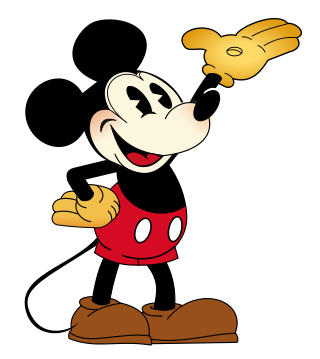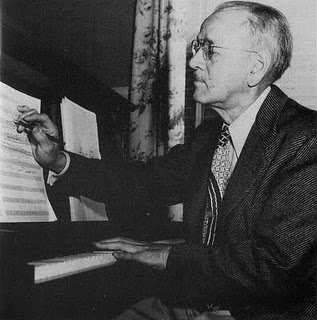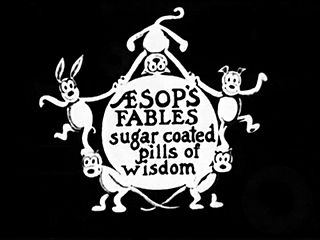Related Research Articles

Mickey Mouse is an American cartoon character co-created in 1928 by Walt Disney and Ub Iwerks. The longtime icon and mascot of the Walt Disney Company. Mickey is an anthropomorphic mouse who typically wears red shorts, large yellow shoes, and white gloves. Inspired by such silent film personalities as Charlie Chaplin and Douglas Fairbanks, Mickey is traditionally characterized as a sympathetic underdog who gets by on pluck and ingenuity in the face of challenges bigger than himself. The character's depiction as a small mouse is personified through his diminutive stature and falsetto voice, the latter of which was originally provided by Disney. Mickey is one of the world's most recognizable and universally acclaimed fictional characters.

Plane Crazy is a 1928 American animated short film directed by Walt Disney and Ub Iwerks. The cartoon, released by the Walt Disney Studios, was the first appearance of Mickey Mouse and his girlfriend Minnie Mouse, and was originally a silent film. It was given a test screening to a theater audience on May 15, 1928, and an executive from Metro-Goldwyn-Mayer saw the film, but failed to pick up a distributor. Later that year, Disney released Mickey's first sound cartoon, Steamboat Willie, which was an enormous success; Plane Crazy was officially released as a sound cartoon on March 17, 1929. It was the fourth Mickey film to be given a wide release after Steamboat Willie, The Gallopin' Gaucho and The Barn Dance (1929).

Minnie Mouse is an American cartoon character created by the Walt Disney Company. As the longtime sweetheart of Mickey Mouse, she is an anthropomorphic mouse with white gloves, a red or pink bow, blue polka-dotted dress, white bloomers and low-heeled shoes occasionally with ribbons on them. The Mickey Mouse comic strip story "The Gleam" by Merrill De Maris and Floyd Gottfredson first gave her full name as Minerva Mouse, although this is seldom used.

Carl William Stalling was an American composer, voice actor and arranger for music in animated films. He is most closely associated with the Looney Tunes and Merrie Melodies shorts produced by Warner Bros., where he averaged one complete score each week, for 22 years.
The golden age of American animation was a period in the history of U.S. animation that began with the popularization of sound synchronized cartoons in 1928, gradually ending in the 1960s when theatrical animated shorts started to lose popularity to the newer medium of television. Animated media from after the golden age were produced on cheaper budgets and with more limited animation techniques between the 1960s and 1970s. The theatrical animation of the golden age peaked in the 1930s and 1940s, while the period is subdivided as the silver age for the rest of its animation produced in the 1950s and 1960s; which includes the latest theatrical animations produced by Walt Disney and Walter Lantz, the latest theatrical cartoons of MGM and Warner Bros., Hanna-Barbera's earliest animated television series and DePatie–Freleng's earliest theatrical cartoons. Furthermore, the history of animation became very important as an artistic industry in the United States.

Felix the Cat is a cartoon character created in 1919 by Pat Sullivan and Otto Messmer during the silent film era. An anthropomorphic young black cat with white eyes, a black body, and a giant grin, he is often considered one of the most recognized cartoon characters in history. Felix was the first fully realized animal character in the history of American film animation.

The Gallopin' Gaucho is a 1928 American animated short film and the second short film featuring Mickey Mouse to be produced, following Plane Crazy and preceding Steamboat Willie. The Disney studios completed the silent version in August 1928, but did not release it in order to work on Steamboat Willie. The Gallopin' Gaucho was released, with sound, after Steamboat Willie on December 30 of the same year.
The Van Beuren Corporation was a New York City-based animation studio that produced theatrical cartoons as well as live-action short-subjects from the 1920s to 1936.
Burton F. Gillett was a director of animated films. He is noted for his Silly Symphonies work for Disney, particularly the 1932 short film Flowers and Trees and the 1933 short film Three Little Pigs, both of which were awarded the Academy Award for Best Animated Short Film and both of which were selected for inclusion in the National Film Registry.

Aesop's Fables is a series of animated short subjects, created by American cartoonist Paul Terry. Produced from 1921 to 1933, the series includes The Window Washers (1925), Scrambled Eggs (1926), Small Town Sheriff (1927), Dinner Time (1928), and Gypped in Egypt (1930). Dinner Time is the first cartoon with a synchronized soundtrack ever released to the public. The series provided inspiration to Walt Disney to found the Laugh-O-Gram Studio in Kansas City, Missouri, where he created Mickey Mouse.

Farmer Al Falfa, also known as Farmer Alfalfa, is an animated cartoon character created by American cartoonist Paul Terry. He first appeared in Down On the Phoney Farm (1915), a short Terry cartoon distributed by the Thanhouser Company. Next came a series of shorts produced by Terry for Bray Studios, starting with Farmer Al Falfa's Cat-Tastrophe (1916).

Mickey Mouse is a series of American animated comedy short films produced by Walt Disney Productions. The series started in 1928 with Steamboat Willie and ended in 2013 with Get a Horse!, taking a hiatus from 1953 to 1983. The series is notable for its innovation with sound synchronization and character animation, and also introduced well-known characters such as Mickey Mouse, Minnie Mouse, Donald Duck, Daisy Duck, Pluto and Goofy.
In animation and film, "Mickey Mousing" is a film technique that syncs the accompanying music with the actions on screen, "Matching movement to music", or "The exact segmentation of the music analogue to the picture." The term comes from the early and mid-production Walt Disney films, where the music almost completely works to mimic the animated motions of the characters. Mickey Mousing may use music to "reinforce an action by mimicking its rhythm exactly. ... Frequently used in the 1930s and 1940s, especially by Max Steiner, it is somewhat out of favor today, at least in serious films, because of overuse. However, it can still be effective if used imaginatively". Mickey Mousing and synchronicity help structure the viewing experience, to indicate how much events should impact the viewer, and to provide information not present on screen. The technique "enable[s] the music to be seen to 'participate' in the action and for it to be quickly and formatively interpreted ... and [to] also intensify the experience of the scene for the spectator." Mickey Mousing may also create unintentional humor, and be used in parody or self-reference.

Paul Houlton Terry was an American cartoonist, screenwriter, film director and producer. He produced over 1,300 cartoons between 1915 and 1955 including the many Terrytoons cartoons. His studio's most famous character is Mighty Mouse, and also created Heckle and Jeckle, Gandy Goose and Dinky Duck.

The Opry House is a 1929 Mickey Mouse short animated film released by Celebrity Pictures, as part of the Mickey Mouse film series. It was the fifth Mickey Mouse short to be released, the second of that year. It cast Mickey as the owner of a small theater. Mickey performs a vaudeville show all by himself. Acts include his impersonation of a snake charmer, his dressing in drag and performing a belly dance, his caricature of a Hasidic Jew and, for the finale, a piano performance of Hungarian Rhapsody No. 2 by Franz Liszt.
The second wave of Walt Disney Treasures was released December 3, 2002. This was the final wave with the tin's individual number embossed on the tin.

Steamboat Willie is a 1928 American animated short film directed by Walt Disney and Ub Iwerks. It was produced in black and white by Walt Disney Studio and was released by Pat Powers, under the name of Celebrity Productions. The cartoon is considered the debut of both Mickey and Minnie Mouse, although both characters appeared several months earlier in a test screening of Plane Crazy. Steamboat Willie was the third of Mickey's films to be produced, but it was the first to be distributed, because Disney, having seen The Jazz Singer, had committed himself to produce one of the first fully synchronized sound cartoons.

The Cactus Kid is a Mickey Mouse short animated film first released on May 10, 1930, as part of the Mickey Mouse film series. It was the eighteenth Mickey Mouse short to be produced, the third of that year.
The Birthday Party is a Mickey Mouse short animated film first released on January 2, 1931, as part of the Mickey Mouse film series. It was the twenty-fifth Mickey Mouse short to be produced, the first of that year.

Milton Mouse is an animated character created at Fables Studios for Paul Terry's cartoon series Aesop's Fables. The character was introduced in 1921, and appeared in dozens of cartoon shorts through 1931. Milton often appeared alongside a girlfriend mouse, usually named Rita.
References
- ↑ Lenburg, Jeff (1999). The Encyclopedia of Animated Cartoons. Checkmark Books. pp. 18–20. ISBN 0-8160-3831-7 . Retrieved June 6, 2020.
- ↑ Grob, Gijs (2018). "Steamboat Willie". Mickey's Movies: The Theatrical Films of Mickey Mouse. Theme Park Press. ISBN 978-1683901235.